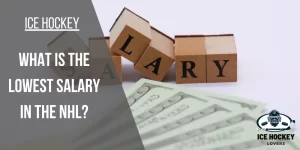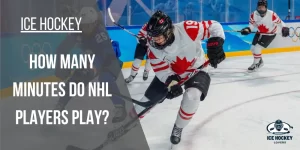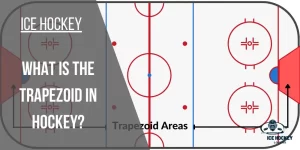Hockey Penalties: A Complete Guide to Penalties in Ice Hockey!

Ice hockey is a quick-motion and highly decisive game in which one team wants to bring down another team quickly. Because of the fast rapid nature game, hockey players sometimes need to make many nanoseconds defensively and offensively decisions to get the upper hand. When they try to do this, they put themselves in trouble. Then officials hand out a penalty measure based on how severe the action is.
A hockey penalty is a punishment given to a player who becomes too physical against the opponent and commits an infraction. The purpose of the penalty is to make players learn a lesson who did illegal actions. There are many types of penalties, minor, major, misconduct, match penalty, and penalty shots. Each has a different punishment range, from minutes to the elimination of the game.
Penalties cover a massive part of games, and events like power play due to a penalty lead to huge scoring chances all around the hockey games.
Let’s jump into these penalties and break down the penalty system of ice hockey to learn how one can spot them.
Table of Contents
Penalty Classifications
Hockey penalties are crucial in maintaining fair play and sportsmanship on the ice. Referees enforce them to penalize players who violate the rules of the game. By gaining a thorough understanding of these penalties, you can not only avoid infractions but also leverage them strategically to gain an advantage over your opponents.
Minor Penalty
Minor penalties are typically less severe infractions that result in the penalized player serving two minutes in the penalty box. These penalties often occur due to minor rule violations or non-aggressive acts. Examples include tripping, hooking, and slashing. The penalized player’s team is forced to play shorthanded, giving the opposing team a temporary advantage.
List of Minor Penalties
- Boarding
- Charging
- Contact to the Head
- Cross-Checking
- Delay of Game
- Elbowing
- Slashing
- Roughing
- High-Sticking
- Kneeing
- Holding
- Holding the Stick
- Interference
- Hooking
- Unsportsmanlike Conduct
- Tripping / Slew Foot
Major Penalty
Major penalties are more severe infractions, resulting in the penalized player serving five minutes in the penalty box. They typically involve actions that risk players’ safety, such as fighting, boarding, or high-sticking. Major penalties significantly impact the penalized player’s team, as they are left shorthanded for an extended period, increasing the advantage for the opposing team.
List of Major Penalties
- Butt-Ending
- Checking from Behind
- Fighting
- Fight Instigator
- Holding / Grabbing the Facemask
- Pushing off the Opponent with a Skate
- Leaving the Bench During Altercation
- Spearing
Misconduct Penalties
Misconduct penalties are given to players for unsportsmanlike conduct or repeated minor infractions. These penalties result in the player being removed from the ice for ten minutes. Although the team does not have to play shorthanded during this time, losing a player can still disrupt their momentum and strategy.
Match Penalties
A match penalty is the most extreme form of all penalties as it directly ejects a player from the game, and a player must head to the dressing room. Whether there are 2 minutes or an hour left, the player must leave the game.
A match penalty is called on a player who clearly intends to injure another player harshly or makes an apparent attempt to injure him. When a match penalty is received, not only a player has to leave a game, but his team also has to play short-handed because another player will serve a 5-minute penalty and is not allowed to return if the other team scores a goal, similar to a major penalty.
However, depending on some leagues, this 5-minute penalty doesn’t require sitting a player in a penalty box at the start of the penalty. After the game stoppage, the team can put a player in the penalty box. If they haven’t put any player until the game stoppage in the penalty box, they cannot place a player to skate on the ice until the next stoppage.
The referee in the game reports the details of each penalty to the NHL management. So, the NHL will determine whether further suspension or fines should be charged to him or not based on the deadliness of action.
Penalty Shots
The penalty shot is one of the game’s most exciting and sensational parts. It’s a one vs. one game, a competition between one player and a goalie. Sometimes, the referee gives a penalty shot instead of conducting a 2-minute minor penalty. It happens when any means of action impedes a clear goal score to take away the scoring chance. This can be done sometimes from behind or when there is an intentional dislodge of the net to avoid a goal and, of course, in some other cases.
So a penalty shot is there to compensate for that chance as there will be no hindrance between a penalty shot-taking player and a goalie, and he has a direct way towards a net to shoot the puck.
- A penalty shot cannot be down in favor of a power play.
- A penalty shot gives a 33% score for a team versus 18% on a power play.
- A penalized player will not receive a 2-minute penalty on personal stats.
Delayed Penalties
A delayed penalty is not called on immediately but instead can be delayed. You will see a referee raise his hand, indicating that a play will continue despite the penalty that has occurred. The game will not be stopped unless the penalized team touches the puck. During a delayed penalty, the team that is not penalized will get his goaltender as an extra attacker knowing that the game will be stopped if penalized team touches the puck. This makes the match scene six vs. five an uneven match.
If a goal is scored during the delayed penalty, it will cancel the penalty and not count. If not, a player must sit in the penalty box after the game stoppage.
Hockey Penalty and Time Chart
| Penalty | Classification | Time |
| Boarding | Minor | 2 or 5 minutes |
| Charging | Minor | 2 minutes |
| Contact to the Head | Minor | 2 minutes |
| Cross-Checking | Minor | 2 or 5 minutes |
| Delay of Game | Minor | 2 minutes |
| Elbowing | Minor | 2 or 5 minutes |
| Slashing | Minor | 2 or 5 minutes |
| Roughing | Minor | 2 minutes |
| Obstruction | Minor | 2 minutes |
| High-Sticking | Minor | 2 minutes |
| Kneeing | Minor | 2 minutes |
| Holding | Minor | 2 minutes |
| Holding the Stick | Minor | 2 minutes |
| Interference | Minor | 2 minutes |
| Hooking | Minor | 2 minutes |
| Unsportsmanlike Conduct | Minor | 2 minutes |
| Tripping | Minor | 2 minutes |
| Butt-Ending | Major | 5 minutes |
| Checking from Behind | Major | 5 minutes |
| Fighting | Major | 5 minutes |
| Fight Instigator | Major | 2 minutes |
| Holding/Grasping the Facemask | Major | 5 minutes |
| Pushing-off of Opponent with Skate | Major | 5 minutes |
| Misconduct | Major | 10 minutes |
| Spearing | Major | 5 minutes |
Frequently Asked Questions
What happens when more than one player gets penalized in the same team?
As it’s a rule, a team will not have players less than three on the ice. So if the team already has three skaters on the ice, then a player will have to go to the penalty box and sit for the designated time, but that player’s penalty will start when one of the previous penalties has ended.
Does the penalty happen at the end and continue to the next period?
Yes, a penalty will surely continue in the next period if it happens at the end.
Consider it as if the player does a 2-minute penalty when only 1 minute is left in the period ending. Then he will serve 1-minute and the remaining 1-minute in the next period.
What is a coincidental penalty?
It is the case when both teams come under a minor penalty at the same game stoppage, which results in 4 vs. 4 on the ice. This differs from the major penalty in which one player substitutes for them to make them 5 vs. 5 on the ice.
Conclusion
In conclusion, penalties bring a player into trouble. The more severe the penalty, the more powerful the punishment. These are critical moments of the game when a player has to decide quickly in split seconds and takes rash action. And they are left with no choice.
Sometimes they do it deliberately as a strategic game as long as it is a minor penalty. But in some cases, luck is not on their side, and they are disadvantaged, making the game difficult for their team. Hence, each penalty type has its consequence, and one has to take responsibility for either making the game trickier for their team or doing it as a strategic part of the game.

Who is Austin Taylor?
Meet Austin Taylor, your go-to source for everything ice hockey! With a passion for the sport that’s as deep as the ice itself, Austin Taylor brings you concise, expert insights and nitty-gritty details on all things hockey. From gear reviews to strategy breakdowns, Austin Taylor is your trusted guide to navigating the exhilarating world of ice hockey. Get ready to lace up your skates and dive into the game with Austin Taylor as your ultimate companion.




